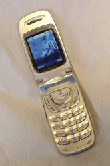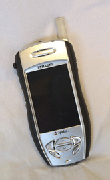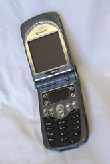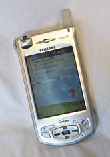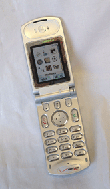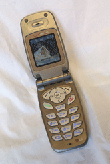Rotary-dial telephones were standard equipment in homes and offices for much of the 20th century until they began to be superseded by Touch-Tone equipment in the 1970s.[IMGCAP(2)]Now wireless phones with built-in Web technology are doing the same: displacing cellular units that have had only a 20-year run.Internet-ready phones started from two different points but are rapidly meeting in the middle.At one end are handheld computer vendors such as Handspring Inc. and Research In Motion Ltd. It wasn't much of a stretch for them to add phone and browsing functions to their products.At the other end, cell phone makers such as Kyocera Wireless Corp., Nokia Inc. and Samsung Electronics Co. Ltd. had to bridge a slightly wider gap to add personal digital assistant functions to their phones.The GCN Lab looked at nine phones that push the current state of the art in functions and usability. Some were more like phones and others more like PDAs, but all converged in the middle zone with fully functional combinations.Some were outstanding at Web browsing. A few could synchronize with desktop PCs. And some high-end units were manageable as network clients. Many of the phones, especially the newer ones, were designed for and are sold exclusively by service providers. In those cases, the table below lists the provider's contact and purchase information rather than the manufacturer's.[IMGCAP(3)]We first tested the phones for interfaces and controls that made it intuitive'or, in a few cases, almost impossible'to reach advanced features.Form factor was also important. Other things being equal, a smaller, lighter unit scored better than a larger, heavier one. The final factor was each unit's price-performance.From the outset, the Samsung SCH-A530 was the top performer. It packed everything short of the kitchen sink into the smallest unit in the review.The tiny flip phone measured just 3.2 inches high and less than an inch thick, yet it had two color LCDs. The first, embedded in the cover, showed at a glance who's calling, the time and the level of wireless service available.The front LCD measured 96 by 64 pixels and could display 256 colors. The main LCD, inside, measured 128 by 160 pixels and could display 65,000 colors. Web browsing was easy and connection speeds were good on the Verizon Wireless network.Other features of this tiny phone impressed us. A Global Positioning System receiver was built in for accessing location-based services such as nearby hotels, and for the new Enhanced 911 emergency locator service.[IMGCAP(4)]The SCH-A530 had voice dialing and text messaging. In 32M of RAM with 128M of flash memory, it could store up to 999 contacts with up to five numbers each, plus contact location. It could sync with a PC via Universal Serial Bus or serial cable, and new features were downloadable from Verizon's Get It Now service.As a bonus, the SCH-A530 was one of the lowest-cost phones in the review. It earned both our Reviewer's Choice and Bang for the Buck designations.If you prefer a phone that looks more like a PDA, the Samsung SPH-i330 would be an excellent choice.It ran the Palm OS 3.5, resembled a Palm m500 and had a large screen. It was a bit longer than wide and felt like a phone handset.We navigated by clicking on the 160- by 240-pixel, 256-color LCD. The typical Palm applications were available: memo pad, contact database, calculator, e-mail program and hot-syncing in the docking cradle.We could dial from the touch screen or program the phone to accept voice dialing. There was enough memory for 30 voice numbers, and the phone also could record 15 minutes of audio.In use, it felt like a cordless phone. An excellent speakerphone, combined with voice dialing, allowed hands-free use while driving. The SPH-i330 was also lightweight at 5.8 ounces.[IMGCAP(5)]Web browsing was very easy with Handspring's Blazer browser on the good-sized color LCD. We found strong voice and data connections to the Sprint PCS network all around our testing area.The SPH-i330 earned a Reviewer's Choice designation as a solid PDA with a natural-seeming phone application.The BlackBerry 6750 deserved to be called the black-magic 6750, because we couldn't figure out how RIM added full phone functionality to the BlackBerry platform without increasing the weight above 5.06 ounces.The 6750 seemed identical to a standard BlackBerry, and BlackBerry users would feel familiar with the integrated e-mail, Short Message Service and organizer applications. Any e-mail going through a Microsoft Exchange or Lotus Domino server could bounce to the 6750, just as with previous BlackBerry models. And there was a QWERTY keyboard at the bottom.[IMGCAP(6)]To use the 6750 as a phone, we dialed from a pad built into the keyboard. RIM could have done a better job segregating the dual-function number keys from the regular keys'they were a bit difficult to find. The letters lit up to make the device usable in the dark.The browser was good for text surfing, but not much in the way of graphics could display on the monochrome screen.The BlackBerry 6750 earned our final Reviewer's Choice designation in this review.The Kyocera 7135 SmartPhone broke the mold of Kyocera's average, reliable line without a lot of extras. The 7135 was a monster of a phone with a ton of extras.The clamshell flip design measured larger than the others in the review, at 4 inches tall by 2.4 inches wide. It weighed in heavily at 6.6 ounces.The phone could operate in three modes'IEEE 802.11b, Bluetooth or wireless WAN'on the Verizon Express network. The signal almost never died, though it occasionally dropped back to analog. Other features included voice-activated dialing, a fairly good speakerphone and an external caller ID display at the top.With Kyocera's Web browser, we could download applications and surf the Web at speeds up to 144 Kbps. There was even a media player for .mov, .avi, .aud and .wmf formats, and the Kyocera could display images in other standard formats. The MP3 player produced very good sound even without the included headset.[IMGCAP(7)]And the Kyocera was a full PDA running Palm OS. Our only real complaint was the comparatively bulky size, though that could be an advantage for large-fingered users.The Handspring Treo 300 looked like a flip phone with a clear visor over the color LCD. At 4.3 inches by 0.7 inches, it was wider but thinner than the Kyocera 7135. It weighed 5.2 ounces.With the screen protector closed, we could still navigate most of the PDA functions using buttons at the bottom of the unit. Opening the screen brought up an entire QWERTY keyboard. The keys lit, and Handspring did an excellent job of pointing out the dial-pad dual keys by coloring them blue. The speakerphone worked very well in our mobile road tests.Users could even disable the phone portion and continue using the PDA where personal phones are forbidden, such as on airplanes. Browsing was extremely easy via dropdown menus that simplified use of multiple functions.The Samsung SGH-i700 was the only phone in the review with the Pocket PC interface. It had some handy features such as creating and sending Microsoft Word documents in an easy-to-use format. The phone features also were fairly easy to use'just point to numbers on the touch screen and hold the device up to your ear.[IMGCAP(8)]The SGH-i700 had a 0.3-megapixel digital camera integrated into the top of the unit and, as minicams go, it was the best we have seen. But don't count on it to capture highly detailed images.The screen was the brightest and clearest in the review.The main problem with the SGH-i700 was its bulk. For $599, a user could just as easily buy a desktop system and have enough left for a cheap wireless phone. Most buyers probably would never get full use out of this phone's many features. The Motorola T720 performed surprisingly well considering its low price. It was bigger than the Samsung SCH-A530 but had the same flip-phone form factor with two LCDs.The interface seemed a little odd. We first had to choose a program group shown on the inside color LCD. Phone functions were under one program icon and PDA functions under another. Web browsing represented a third option. Once the symbols became familiar, however, operation was intuitive.The phone worked well and had extras such as integrated GPS. Programs executed quickly, including advanced games with graphics.For $129, the T720's advanced features at an entry-level price earned a Bang for the Buck designation.The Verizon LG VX4400 looked like a slightly larger cousin of the Samsung SCH-A530. At first glance they seemed to have identical features except for the LG VX4400's monochrome outer display. The internal, main LCD was a little smaller than the SCH-A530's. And, at 3.4 inches by 1.07 inches, the phone itself was a bit bigger.The LG VX4400 worked well but was outclassed by the SCH-A530 at the same price.[IMGCAP(9)]The Nokia 7210 had a sharp color screen and an integrated antenna, and the 1.7-inch unit fit easily in a hand. The screen looked good whether we were phoning, browsing or running basic PDA functions.The problem with the 7210 was bad key layout. The center keys of the dial pad were huge, illuminated buttons, whereas the outer numbers set along the edge of the phone did not fully illuminate and were about half as big.That separation made dialing awkward, and I kept expecting the ad character 'Carrot Top' to jump out and punch C-A-L-L A-T-T down the highlighted center. Perhaps that was intentional, because our test phone used the AT&T Wireless network.The power button, a tiny recessed square at the top of the phone, was very difficult for people with big fingers to push. Long fingernails might help.The faceplate was supposed to be changeable, but try as I might, I couldn't remove the blue faceplate that came with the phone. All I succeeded in doing was loosening the plate enough to gather screen-obscuring dust.Nokia's attempt to add cool features resulted instead in loss of functionality. And at $349, the 7210 was no bargain.
Combo devices meld to form a handy tool that's full of featuresWhat you're used toCaught on in a flashHieroglyphics decoded


